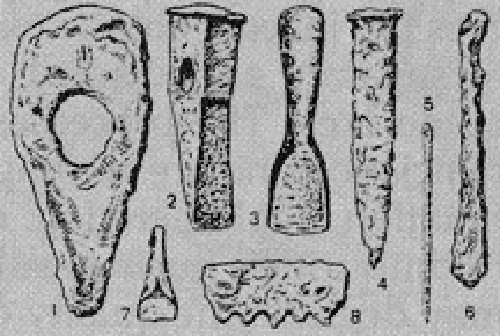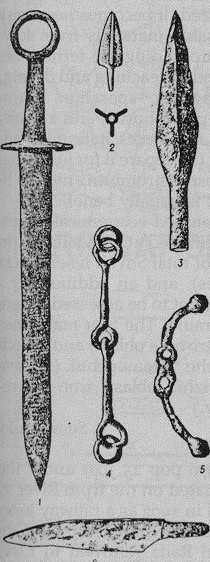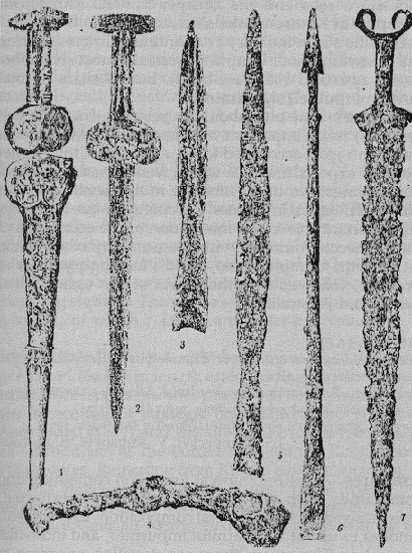Iron Age
Iron Age [залізна доба; zalizna doba]. A cultural-technological era in the development of humankind following the Bronze Age in the 1st millennium BC that was characterized by the diffusion of iron and steel implements and weapons. In western and central Europe it consisted of the Hallstatt culture (800–500 BC) and La Tàene culture (500–1 BC) phases. This periodization is applicable only in western Ukraine, which was penetrated by the Thracian Hallstatt culture and Celtic La Tàene culture. The Iron Age in the rest of Ukraine is divided into three periods: the Cimmerian or Pre-Scythian (8th and 7th centuries BC), the Scythian (7th to 3rd centuries BC), and the Sarmatian (3rd century BC to 4th century AD).
The oldest extant evidence of iron use in Ukraine dates from the late 2nd millennium BC. It was, however, only in the 8th and 7th centuries BC that iron metallurgy was developed and basic tools and weapons began to be made of iron and steel in Ukraine. Stone implements were displaced; bronze implements, however, continued to be widely used well into the Cimmerian and Scythian periods. The unrivaled predominance of iron implements and weapons and the flourishing of iron metallurgy in Ukraine began only toward the end of the Iron Age.
The use of iron tools stimulated the development of agriculture, crafts, trade, and human progress as a whole. In the early Iron Age the population of the Eurasian steppe turned to what was, for that time, a more productive form of animal husbandry: nomadism. It was then that the migration of peoples, and hence frequent armed conflicts, occurred. On Ukraine's territory great tribal alliances coalesced, the earliest state formations emerged, and proto-urban fortified settlements and true ancient cities appeared. In the 7th century BC the Greeks began the colonization of the northern Black Sea littoral and the establishment of city-states there (see Ancient states on the northern Black Sea coast). At the beginning of the Iron Age the territory and population of Ukraine entered the historical arena. In this epoch the population of Ukraine established economic and cultural contacts with the civilizations of the ancient world and was described by Assyrian, Greek, and Roman writers.
In the 8th and 7th centuries BC Ukraine's steppe was inhabited by seminomadic Cimmerian tribes, which archeologists identify with the Timber-Grave culture. In the Cimmerian phase the forest-steppe between the Dnipro River and the Dnister River was occupied by the sedentary agricultural tribes of the Chornyi Lis culture, descendants of the Bronze Age Bilohrudivka culture. Many scholars consider the Chornyi Lis and Bilohrudivka tribes to be the indigenous proto-East Slavic population of Ukraine. Contemporaries of the Cimmerians in Galicia and Volhynia were the tribes of the Lusatian culture; believed to have been the ancestors of the Western Slavs, they came from the territory of Poland during the late Bronze Age. From the 11th to the 6th centuries BC the upper Buh River Basin was populated by the tribes of the Vysotske culture—descendants of both the Lusatian and Chornyi Lis tribes—while western Podilia, Bukovyna, and Transcarpathia were influenced by tribes of the Thracian Hallstatt culture created by the Getae and Dacians.
In the 7th century BC the Scythians penetrated into Ukraine's territory, drove out the Cimmerians, and established a large empire. It has been posited that the agricultural tribes of the Right-Bank forest-steppe called ‘Scythian plowmen’ by Herodotus were in fact descendants of the proto-Slavic Chornyi Lis culture that adopted the culture of the dominant ‘Royal Scythians.’ The forest zone bordering on Scythia was inhabited by ancient Baltic tribes of the Mylohrad-Pidhirtsi culture in the upper Dnipro River Basin and the Yukhnove culture in the middle Desna River Basin. The Crimean mountains were the home of the Kizyl-Koba culture of the Taurians. In Transcarpathia, descendants of the Thracian Hallstatt culture constituted the Kushtanovytsia culture in the 6th to 3rd centuries BC. In the course of the 2nd and 1st centuries BC the indigenous Thracian and proto-Slavic population of Transcarpathia, western Podilia, Bukovyna, Galicia, and Volhynia intermingled with the Celtic tribes of the La Tàene culture that spread there from central Europe.
In the 3rd and 2nd centuries BC the Sarmatians displaced the Scythians from most of the Ukrainian steppe, and the Scythians remaining in the lower Dnipro River Basin and the Crimean steppe founded so-called Minor Scythia with its capital at Neapolis near present-day Simferopol. In the 1st century BC the Getae expanded into the lower Dnipro River and the Dnister River basins. During the next three centuries they and the Dacians created the Lypytsia culture in the upper Dnister Basin. In the forest-steppe between the Dnister River and the Dnipro River the Zarubyntsi culture, considered by most scholars to have been proto-Slavic, flourished from the 3rd century BC through the 1st century AD until it was destroyed by the Sarmatians' expansion into the middle Dnipro Basin. Its remnants, pushed into the upper Dnipro Basin, together with Baltic tribes created the Kyivan culture of the 2nd to 4th centuries AD. In the forest-steppe and steppe zones between the Dnister River and Donets River in the 2nd to 5th centuries AD, the multiethnic (Sarmatian, Scythian, Thracian, and proto-Slavic) Cherniakhiv culture emerged under the strong influence of the neighboring Roman provinces of the Danube River Basin. At that time Subcarpathia was dominated by the Carpathian Burial-Mound culture of the Thracian Carpi. In the 3rd and 4th centuries AD the ancestors of the Western Slavs and Germanic Vandals—the tribes of the Przeworsk culture—and Germanic Goths and Gepidae penetrated from the Baltic region and the Vistula River Basin into the Cherniakhiv and Carpathian Burial-Mound cultural zones. The Goths moved on into the northern Black Sea littoral, where in the late 4th century AD they, the Sarmatians, the tribes of the Cherniakhiv culture, and the remaining Hellenic city-states were conquered by the invading Turkic Huns. The ensuing decline and desertion of the core territory of Ukraine in the late 4th and 5th centuries AD ended the Iron Age there.
BIBLIOGRAPHY
Liapushkin, I. Dneprovskoe lesostepnoe levoberezh’e v epohu zheleza, vol 104 of Materialy i issledovaniia po arkheologii SSSR (Moscow–Leningrad 1961)
Pasternak, Ia. Arkheolohiia Ukraïny (Toronto 1961)
Terenozhkin, A. Predskifskii period na dneprovskom Pravoberezh’e (Kyiv 1961)
Sulimirski, T. Prehistoric Russia (London 1970)
Arkheolohiia Ukraïns’koï RSR, vols 2–3 (Kyiv 1971, 1975)
Volodymyr Mezentsev
[This article originally appeared in the Encyclopedia of Ukraine, vol. 2 (1988).]



